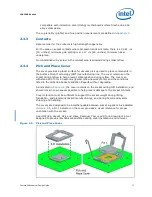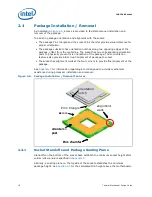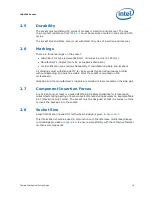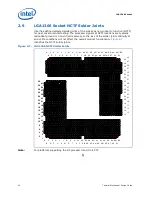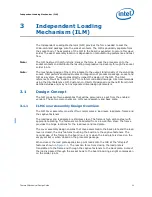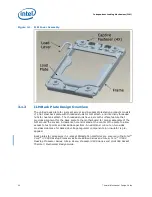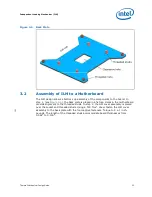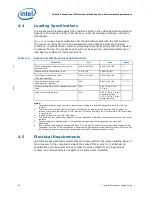
Thermal/Mechanical Design Guide
21
Independent Loading Mechanism (ILM)
3
Independent Loading
Mechanism (ILM)
The Independent Loading Mechanism (ILM) provides the force needed to seat the
1366-LGA land package onto the socket contacts. The ILM is physically separate from
the socket body. The assembly of the ILM to the board is expected to occur after wave
solder. The exact assembly location is dependent on manufacturing preference and test
flow.
Note:
The ILM has two critical functions: deliver the force to seat the processor onto the
socket contacts and distribute the resulting compressive load evenly through the socket
solder joints.
Note:
The mechanical design of the ILM is integral to the overall functionality of the LGA1366
socket. Intel performs detailed studies on integration of processor package, socket and
ILM as a system. These studies directly impact the design of the ILM. The Intel
reference ILM will be “build to print” from Intel controlled drawings. Intel recommends
using the Intel Reference ILM. Custom non-Intel ILM designs do not benefit from Intel's
detailed studies and may not incorporate critical design parameters.
3.1
Design Concept
The ILM consists of two assemblies that will be procured as a set from the enabled
vendors. These two components are ILM cover assembly and back plate.
3.1.1
ILM Cover Assembly Design Overview
The ILM Cover assembly consists of four major pieces: load lever, load plate, frame and
the captive fasteners.
The load lever and load plate are stainless steel. The frame is high carbon steel with
appropriate plating. The fasteners are fabricated from a low carbon steel. The frame
provides the hinge locations for the load lever and load plate.
The cover assembly design ensures that once assembled to the back plate and the load
lever is closed, the only features touching the board are the captive fasteners. The
nominal gap of the frame to the board is ~1 mm when the load plate is closed on the
empty socket or when closed on the processor package.
When closed, the load plate applies two point loads onto the IHS at the “dimpled”
features shown in
Figure 3-1
. The reaction force from closing the load plate is
transmitted to the frame and through the captive fasteners to the back plate. Some of
the load is passed through the socket body to the board inducing a slight compression
on the solder joints.
Summary of Contents for X5550 - Quad Core Xeon
Page 8: ...8 Thermal Mechanical Design Guide ...
Page 12: ...Introduction 12 Thermal Mechanical Design Guide ...
Page 24: ...Independent Loading Mechanism ILM 24 Thermal Mechanical Design Guide Figure 3 3 ILM Assembly ...
Page 26: ...Independent Loading Mechanism ILM 26 Thermal Mechanical Design Guide ...
Page 48: ...Component Suppliers 48 Thermal Mechanical Design Guide ...
Page 82: ...Mechanical Drawings 82 Thermal Mechanical Design Guide ...
Page 88: ...Socket Mechanical Drawings 88 Thermal Mechanical Design Guide ...











